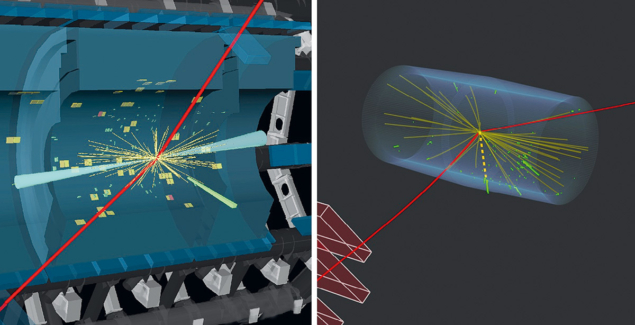
The discovery of the Higgs boson in 2012 unleashed a detailed programme of measurements by ATLAS and CMS which have confirmed that its couplings are consistent with those predicted by the Standard Model (SM). However, several Higgs-boson decay channels have such small predicted branching fractions that they have not yet been observed. Involving higher order loops, these channels also provide indirect probes of possible physics beyond the SM. ATLAS and CMS have now teamed up to report the first evidence of the decay H → Zγ, presenting the combined result at the Large Hadron Collider Physics conference in Belgrade in May.
The SM predicts that approximately 0.15% of Higgs bosons produced at the LHC will decay in this way, but some theories beyond the SM predict a different decay rate. Examples include models where the Higgs boson is a neutral scalar of different origin, or a composite state. Different branching fractions are also expected for models with additional colourless charged scalars, leptons or vector bosons that couple to the Higgs boson, due to their contributions via loop corrections.
“Each particle has a special relationship with the Higgs boson, making the search for rare Higgs decays a high priority,” says ATLAS physics coordinator Pamela Ferrari. “Through a meticulous combination of the individual results of ATLAS and CMS, we have made a step forward towards unravelling yet another riddle of the Higgs boson.”
We have made a step forward towards unravelling yet another riddle of the Higgs boson
Previously, ATLAS and CMS independently conducted extensive searches for H → Zγ. Both used the decay of a Z boson into pairs of electrons or muons, which occur in about 6.6% of cases, to identify H → Zγ events. In these searches, the collision events associated with this decay would be identified as a narrow peak over a smooth background of events.
In the new study, ATLAS and CMS combined data that was collected during the second run of the LHC in 2015–2018 to significantly increase the statistical precision and reach of their searches. This collaborative effort resulted in the first evidence of the Higgs boson decay into a Z boson and a photon, with a statistical significance of 3.4σ. The measured signal rate relative to the SM prediction was found to be 2.2 ± 0.7, in agreement with the theoretical expectation from the SM.
“The existence of new particles could have very significant effects on rare Higgs decay modes,” says CMS physics coordinator Florencia Canelli. “This study is a powerful test of the Standard Model. With the ongoing third run of the LHC and the future High-Luminosity LHC, we will be able to improve the precision of this test and probe ever rarer Higgs decays.”
Further reading
ATLAS Collab. 2023 ATLAS-CONF-2023-025.
CMS Collab. 2023 CMS PAS HIG-23-002.







